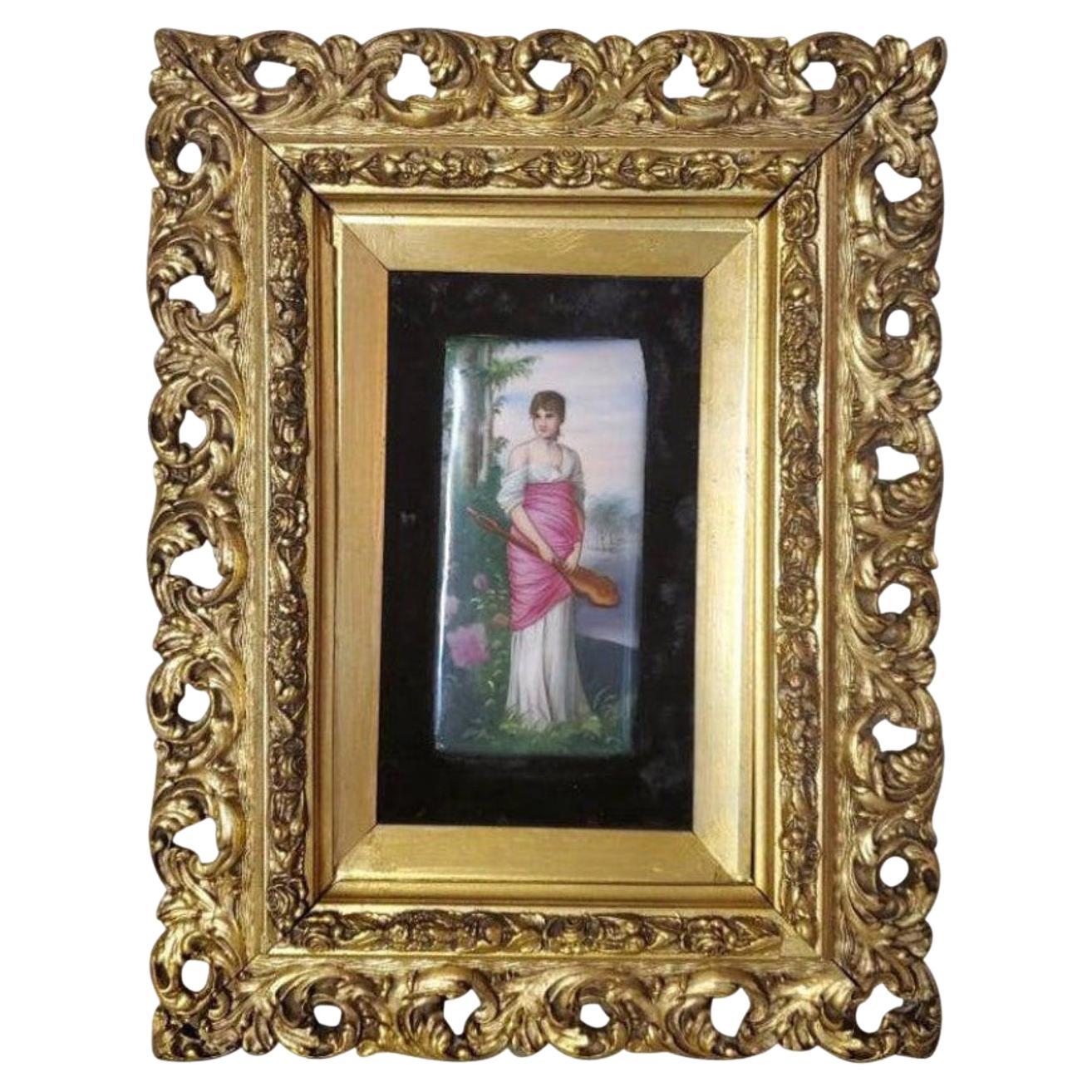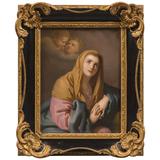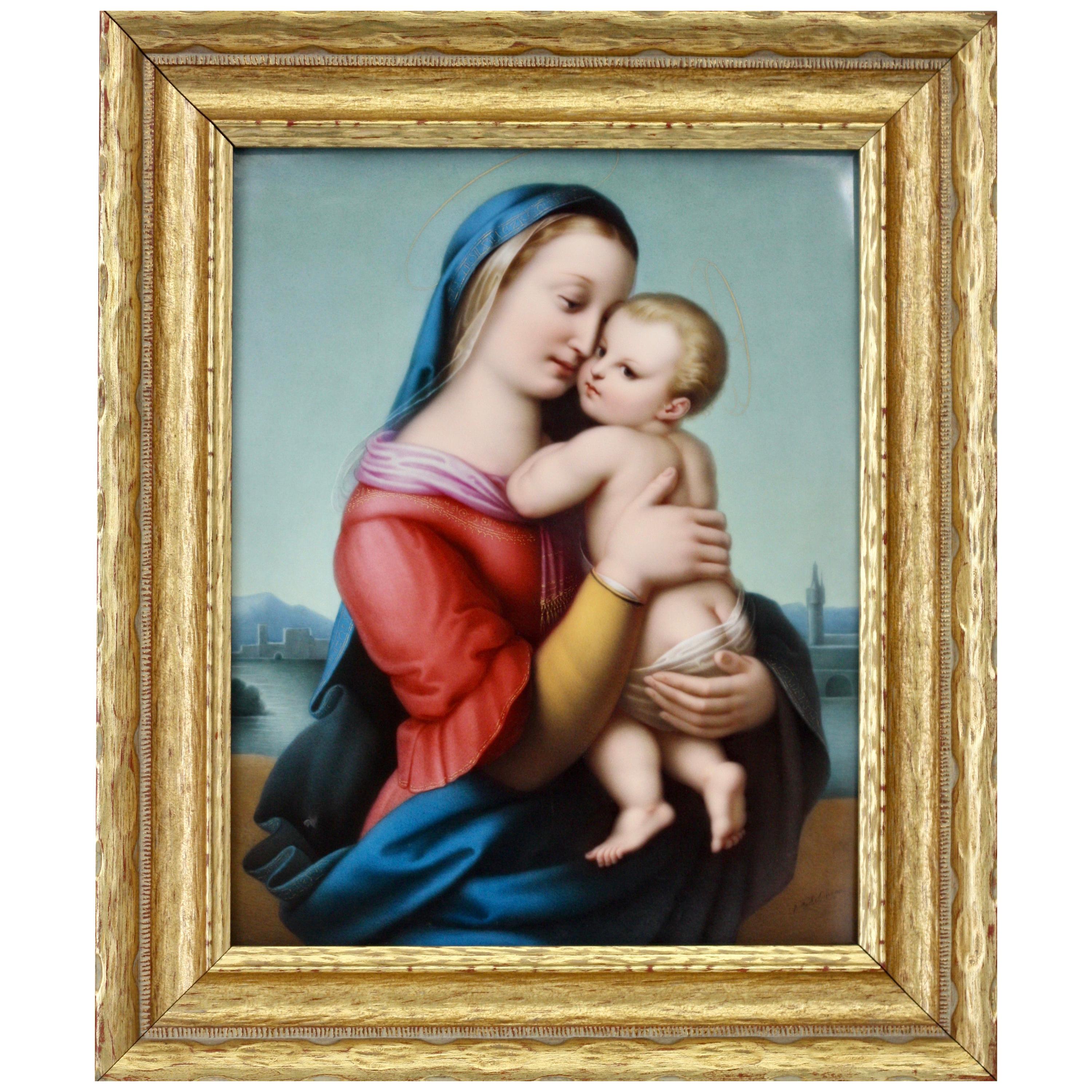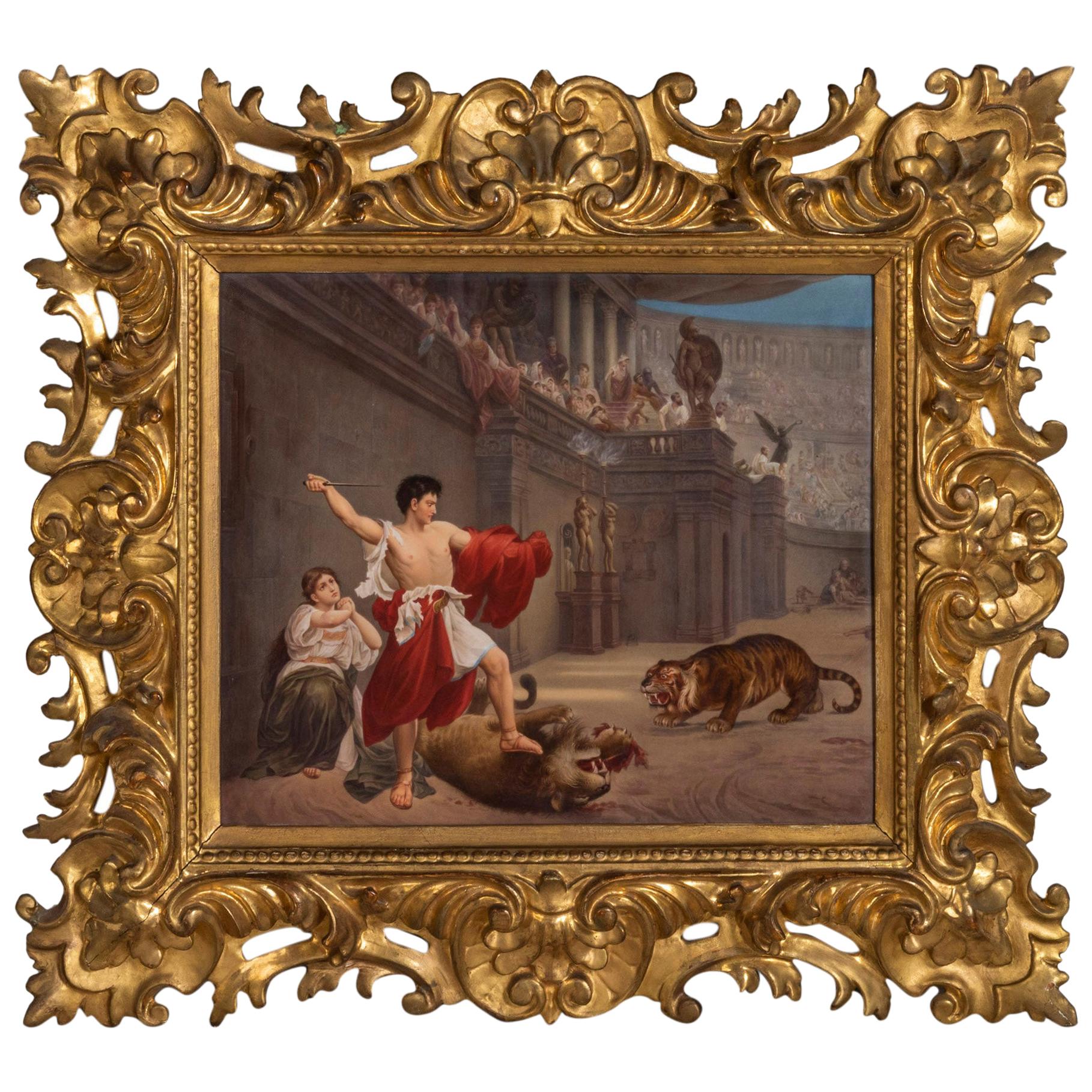Items Similar to Antique Berlin KPM Plaque 'KUNST BRINGT GUNST On Stand 19th Century
Want more images or videos?
Request additional images or videos from the seller
1 of 21
Antique Berlin KPM Plaque 'KUNST BRINGT GUNST On Stand 19th Century
About the Item
This is an absolutely stunning and finely painted KPM Berlin Plaque after Paul Thumann's (1834-1908) 'Kunst Bringt Gunst' (meaning 'Art wins heart'), signed Knouller and raised on a decorative gilt bronze easel stand, circa 1880 in date.
This magnificent plaque is portrait in shape and depicts a candid young girl watching a graceful Greek artist while he is decorating a pottery vase. The young artisan is painting a black figure on the surface of the amphora while she is standing tall at the doorway and watching him.
Both figures dress in classical clothes and are set within a nostalgic environment reminiscent of antique ruins and of a paradisiac landscape. Indeed, a sweet and almost melancholy calm prevails. The original painting by the German artist, Thumann, just like many other of his romantic paintings, became very popular and was widely reproduced on porcelain plaques, plates and vases.
This truly splendid plaque is signed to the left bottom corner 'Knouller' and bears the impressed sceptre mark for KPM and comes with a Rococo style bronze stand.
It is set in its original splendid gilt frame displaying foliate decorations to the border and riased on a decorative gilt bronze easel stand.
Add this splendid antique plaque to a very special wall in your home.
Condition:
The plaque, the gilded frame and the easel are all in excellent condition, please see photos for confirmation.
Dimensions in cm:
Height 24 cm x Width 18 cm x Depth 2.5 cm - Framed Plaque
Height 43 cm x Width 20 cm x Depth 16 cm - Easel Stand
Dimensions in inches:
Height 9 inches x Width 7 inches x Depth 1 inch - Framed Plaque
Height 1 foot, 5 inches x Width 8 inches x Depth 6 inches - Easel Stand
The Royal Porcelain Factory in Berlin (German: Königliche Porzellan-Manufaktur Berlin, abbreviated as KPM), also known as the Royal Porcelain Manufactory Berlin and whose products are generally called Berlin porcelain, was founded in 1763 by King Frederick II of Prussia (known as Frederick the Great). Its actual origins, however, lie in three private enterprises which, under crown patronage, were trying to establish the production of "white gold" (i.e. porcelain) in Berlin from the mid-18th century onwards.
Before KPM was founded, two attempts had already been made to establish a porcelain manufactory in Berlin. In 1751, the Berlin wool manufacturer Wilhelm Caspar Wegely was granted the royal privilege to set up a porcelain manufactory in Berlin. Furthermore, Frederick II of Prussia granted him exemption from duties for the import of essential materials and assured him of the exclusion of all competition.
Wegely hired first-class craftsmen from his competitors, and appointed the porcelain sculptor Ernst Heinrich Reichard to the post of chief modeller. However, technical difficulties and the Seven Years' War between Prussia and Saxony soon proved to be the enterprise's downfall. In 1757, he dissolved his company and sold its inventories, equipment and materials to the Berlin businessman Johann Ernst Gotzkowsky.
In 1761, the second porcelain manufactory in Berlin started its operations. Gotzkowsky concluded an agreement with Wegely's chief modeller, Ernst Heinrich Reichard, who was in possession of the secret formula known as the arcanum. Reichard received 4,000 thaler for the arcanum, and another 3,000 for the stock of porcelain and other materials. Furthermore, he undertook to work for Gotzkowsky as a keeper of the arcanum and as the manager. Gotzkowsky also agreed to take over Reichard's eight workers.
Appreciated and supported by the King of Prussia, Gotzkowsky managed to attract important artists and qualified employees. Right at the start, Gotzkowsky appointed Friedrich Elias Meyer, a pupil of Johann Joachim Kändler who came from Meissen, to the post of chief modeller, and Carl Wilhelm Boehme to the post of head of the porcelain-painting department. Gotzkowsky bought another building next to his own property at Leipziger Straße 4, and he began to build a manufactory on the site.
Nevertheless, Gotzkowsky's finances began to deteriorate. Since the royal exchequer was in the red on account of the war, Gotzkowsky believed that he stood little or no chance of obtaining assistance from the king. The end of the war also signalled the end for Gotzkowsky's manufactory.
Today, the porcelain pieces from the early days marked with a W for Wegely und a G for Gotzkowsky are extremely rare and highly coveted collector's items.
On 19 September 1763, Frederick II officially became the manufactory's new owner. He purchased the manufactory for the considerable sum of 225,000 thaler and took over the staff of 146 workers. He gave the business its name and allowed it to use the royal sceptre as its symbol. From then on, it was called the Königliche Porzellan-Manufaktur Berlin ("Royal Porcelain Manufactory Berlin") and became a model of how to run a business. There was no child labour, there were regular working hours, above-average incomes, secure pensions, a healthcare fund and assistance for widows and orphans.
In 1784, after a four-year development period, the king's desire for a soft and delicate shade of blue was fulfilled. The colour was known as Bleu mourant ("dying blue"), and it was used to decorate Neuzierat, Frederick's favourite dinner service. The colour was predominant in the king's private chambers at Sanssouci Palace and in the blue chamber of the New Palace in Potsdam, as well as in other castles.
As owner of KPM, the king used the "white gold" as an effective means of diplomacy. Almost all of his diplomatic presents came from the manufactory, and they were to be found at the court of the tsars in Russia and on the tables of European aristocracy. Under Frederick the Great's successor, his nephew Frederick William II, the manufactory became a technologically leading enterprise. The new king obtained what he needed in the way of porcelain from KPM, but stopped paying cash. The amounts due were deducted from his share of the profits. The manufactory flourished. From 1787 onwards, the average annual net profit came to more than 40,000 thaler.
Our reference: A1094b
- Dimensions:Height: 16.93 in (43 cm)Width: 7.88 in (20 cm)Depth: 6.3 in (16 cm)
- Materials and Techniques:
- Period:
- Date of Manufacture:circa 1880
- Condition:
- Seller Location:London, GB
- Reference Number:
About the Seller
5.0
Platinum Seller
These expertly vetted sellers are 1stDibs' most experienced sellers and are rated highest by our customers.
Established in 1983
1stDibs seller since 2012
1,199 sales on 1stDibs
Typical response time: <1 hour
Associations
LAPADA - The Association of Arts & Antiques Dealers
- ShippingRetrieving quote...Ships From: London, United Kingdom
- Return PolicyA return for this item may be initiated within 14 days of delivery.
More From This SellerView All
- Antique Berlin Oval Porcelain Plaque Young Woman Ormolu Frame, 19th CenturyLocated in London, GBThis is a stunning and unique antique Berlin framed porcelain plaque, circa 1870 in date. This magnificent plaque is oval in shape with an ...Category
Antique 1870s German Porcelain
MaterialsOrmolu
- Antique English School Oil on Panel Floral Still Life Painting 19th CenturyLocated in London, GBThis is a beautiful English School antique oil on panel paintings of a still life, 19th century in date. The oil on panel painting depdicts a beautiful still life of roses, irises, ...Category
Antique 19th Century English Paintings
MaterialsOther
- Antique Oil on Canvas Painting by Francesco Bergamini Dated 1894, 19th CBy Francesco Bergamini 1Located in London, GBThis is a truly splendid antique oil on canvas painting featuring a period interior scene by Francesco Bergamini (1851-1900) Italian, signed and dated 1894. This beautiful oil pai...Category
Antique 1890s Italian Paintings
MaterialsCanvas, Giltwood
- Antique Painting "Sunset at Low Tide" William Langley 19th CenturyBy William LangleyLocated in London, GBThis is a beautiful English antique oil on canvas paintings of "Sunset at Low Tide"by William Langley (English, 1852-1922), and signed lower left. The paintings depdict sailing boats at sea, with fishermen and boats on the beach. The artist has used a very delicate palette of colours and has succeeded in adding some mystery to the scene. Housed in a beautiful giltwood frame. Several examples of his work have sold at top auction...Category
Antique 19th Century Paintings
MaterialsCanvas
- Antique Pair of Seascape Oil Paintings Fishing Boats, 19th CenturyLocated in London, GBA wonderful pair of seascape paintings of fishing boats attributed to William Mcalpine (British 19th century) titled 'Beached Fishing Vessels' and 'Shipping in Rough Seas', circa 186...Category
Antique 1860s British Paintings
MaterialsCanvas
- Antique Italian Water Colour Titled "Contadino Di Sabina", 19th CenturyLocated in London, GBThis is a beautiful and decorative antique Italian watercolour titled "Contadino Di Sabina" and dating from the mid 19th century. The th...Category
Antique 1850s Italian Paintings
MaterialsOther
You May Also Like
- 'Erblüth' a Large 19th Century Berlin 'KPM' Porcelain PlaqueBy Königliche Porzellan-Manufaktur (KPM)Located in Brighton, West Sussex'Erblüth' a large and very fine Berlin (KPM) Porcelain plaque, after Angelo Asti. In a giltwood and composition shadow box frame. Signed 'Weigel', impr...Category
Antique 19th Century German Paintings
MaterialsPorcelain, Giltwood
- 19th Century KPM Berlin Painted Porcelain Plaque, Die LautenspielerinBy KPM PorcelainLocated in Forney, TXA late 19th century Berlin KPM painted porcelain plaque, Die Lautenspielerin, in pierced foliate giltwood frame, painting after Friedrich August von Kaulbach (German, 1850-1920). Mod...Category
Antique Late 19th Century Victorian Paintings
MaterialsPorcelain, Giltwood, Paint
- Large 19th Century Berlin Rectangular KPM Porcelain Painted Framed PlaqueBy KPM PorcelainLocated in Los Angeles, CAA large 19th century Berlin Rectangular K.P.M porcelain painted framed plaque Germany, circa 1880 Very well painted depicting a women draped in linens with two angels above h...Category
Antique 1880s German Napoleon III Paintings
MaterialsPorcelain
- Berlin KPM Porcelain Plaque Last Quarter of the 19th Century after RaphaelBy KPM PorcelainLocated in West Palm Beach, FLA Berlin KPM Porcelain Plaque Last quarter of the 19th century After Raphael, depicting Madonna and child with a river and city in the distance, signed A. Deckelmann, impressed ...Category
Antique 19th Century Paintings
MaterialsPorcelain
- Kpm Berlin Hand Painted Porcelain Portrait Plaque of Ruth in Frame, 19th CenturyBy KPM PorcelainLocated in Gardena, CAKPM Berlin hand painted porcelain portrait plaque of Ruth in Frame, 19th century. 19th century KPM Berlin porcelain portrait plaque of Ruth in frame. Oval-shaped porcelain plaque featuring the portrait of a young woman. Apparently unsigned, the reverse with incised KPM marks...Category
Antique 19th Century Paintings
MaterialsPorcelain
- A Berlin (K.P.M.) Porcelain Plaque, Late 19th CenturyLocated in West Palm Beach, FLA Berlin (K.P.M.) porcelain plaque, Late 19th century finely painted after Defregger with a man fighting lions in ancient Rome impressed to verso KPM with sceptre mark Size with ...Category
Antique Late 19th Century Paintings
MaterialsPorcelain





